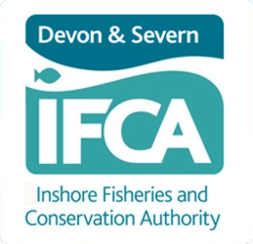Mussels
Page review/updated 13/05/2025
(Content of page last updated: 13th May 2025)
MUSSELS IN D&S IFCA’S DISTRICT
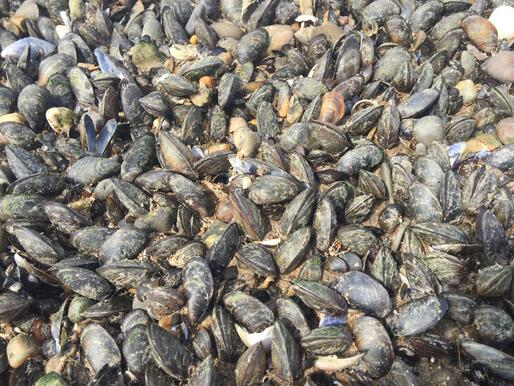
Blue mussels, Mytilus edulis, have historically been abundant within D&S IFCA’s District, though this species has experienced declines around the country in recent years. Mussels are reef building, filter-feeding bivalves, found both intertidally and in the shallow sublittoral; they act as important ecosystem engineers within many of the District’s estuaries. They feed mostly on particulate organic matter (POM), and aggregate in habitats where the oceanographic and environmental conditions facilitate high loads of POM, i.e. the turbid channels within estuarine systems. Key to their ability to form large reef structures is their ability to excrete byssus: sticky treads that bind individual mussels to their environment, including the shells of both living and dead mussel. These reefs not only provide substrate for new mussel settlement, but also create a spatially complex habitat utilised by a plethora of species, supporting numerous food webs.
Wading birds are just one of the groups highly dependent on mussel beds. This is an important factor when considering the management necessary for certain estuaries. There are various legislative mechanisms applied at international, European, and national levels which protect wading birds and promote population recovery. One mechanism to aid this is by ensuring that there is adequate provision of the food source for these birds. For example, the oystercatcher Haematopus ostralegus is a designated feature of some of the District’s MPAs and having an abundant supply of mussels is essential for the maintenance of overwintering populations.
D&S IFCA’s officers monitor mussel populations within several of the District’s estuaries on an annual or biennial basis. Based on the total estimated biomass of mussels within an estuary, D&S IFCA may apply management measures necessary to protect a portion of the stock necessary for the wading bird populations. These decisions may come in the form of restrictions on the amount of mussel removed, or alternatively in the form of prohibitions on removal of mussel from defined areas within the estuary should the stock be severely depleted.
MUSSEL STOCK SURVEY METHODOLOGY
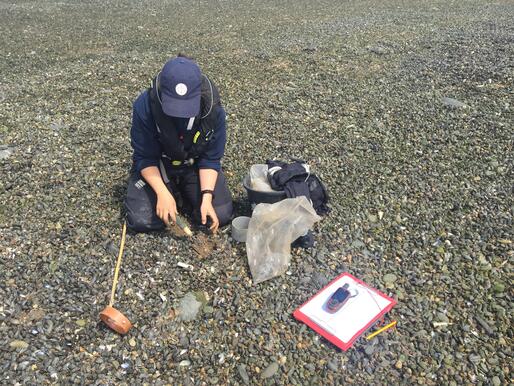
In order to understand how much mussel is present in an estuary and whether the beds are changing it is necessary to survey the beds in-situ. Surveys are subject to tidal constraints, and are carried out at low water during spring tides, when the greatest proportion of the beds will be exposed. D&S IFCA uses the ‘Dutch Wand’ survey technique, developed by Dutch researchers who survey mussels in the Wadden Sea. The technique is accurate, having comparable results on density and biomass of mussel beds to more conventional quadrat surveys, but importantly it is also faster without the loss of resolution.
Using the survey data it is possible to calculate approximately how much mussel is present within a certain bed, whether this mussel is old or freshly settled and whether there have been any changes in the bed’s density, percentage cover and spatial coverage year on year. It is also possible to use the shellfish data alongside data on local wading bird populations to calculate how much of the stock is likely to be consumed by overwintering birds, and therefore how much may be available to a local fishery without impinging on the bird populations. This has been an important part of the management of mussel populations on the Taw-Torridge in particular. (see below).
Using the hit and miss data, sample data and GPS data it is possible to calculate approximately how much mussel is present within a certain bed, whether this mussel is old or freshly settled and whether there have been any changes in the bed’s density, and location as well as the bed’s spatial coverage year on year.
In addition to D&S IFCA’s calculations and inferences on the stock based on these data, Natural England then uses these data, in conjunction with that year’s wading bird estimates and feeding rates, to calculate exactly how much of this mussel stock is likely to be consumed by wading birds for that year per estuary.
EXE ESTUARY
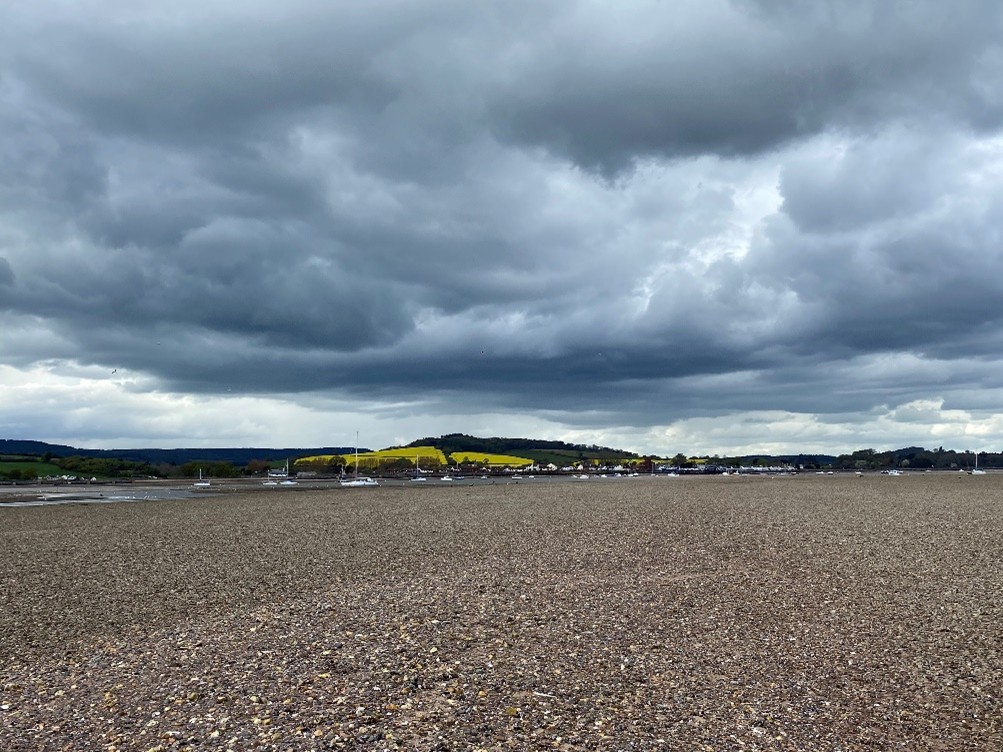
The Exe Estuary is currently one of the estuaries subject to a prohibition on the removal of mussels from certain areas of public beds. The prohibition was introduced under D&S IFCA’s ‘Byelaw 9 – Temporary Closure of Shellfish Beds’ and started on 1st May 2019. The prohibition was required due to the severe decline of mussel on many of the estuary’s beds following large storms in the winter of 2013-14 and subsequent but unrelated harmful algal bloom events. The beds in their pre-2014 extent covered much of the intertidal parts of the estuary, notably on Bull Hill Bank, Starcross, and at Lympstone with a combined estimate of around 2000 tonnes. This dropped sharply in 2014 to less than 100 tonnes and was estimated at less than one tonne in 2019. These beds have not since recovered to pre-2014 levels, prompting the prohibition. Since 2019 only sparse mussel has been detected on Bull Hill. Recovery from a bed of the current size to Bull Hill’s previous population levels, even without disturbance and with the Temporary Shellfish Closure, may take a considerable amount of time.
Exe Estuary Stock Assessment Reports:
- Exe Estuary Mussel Stock Assessment 2024 (February 2025)
- Exe Estuary Mussel Stock Assessment 2022 (V1.1 – November 2022)
- Exe Estuary Mussel Stock Assessment 2020 (V1.0 – March 2021)
A collection of older reports can be found in Section H (Mollusca/Mussels) of the Resource Library.
TEIGN ESTUARY
The mussel beds on the Teign Estuary were first surveyed by D&S IFCA in 2012, and since then have been surveyed annually between 2018–2020 and biennially since 2020.There have historically been large mussel beds present in the estuary, particularly below the Shaldon Bridge on the Salty and at Polly Steps. Hand gathering for mussels and cockles has taken place for generations on these beds. D&S IFCA’s surveys of these beds help to monitor the mussel stocks to ensure they are not overexploited. The data collected will inform any future management of the mussel beds and the development of shellfisheries in this part of the Devon & Severn District.
Mussel populations within the Teign crashed between the 2012 and 2018 stock assessments, possibly due to the large storms in 2014 which may have scoured away once-previously stable beds, and due to intentional removal of raised areas of mussel around boat moorings on the Salty. Since these events, mussel populations have been unable to recover to anywhere near the previous population estimates and both The Salty and Polly Steps are no longer areas on which large expanses of dense live mussel are found. The public mussel beds within the Teign Estuary were closed to removal of mussels from the 1st May 2019. D&S IFCA will continue to undertake surveys to monitor for signs of population recovery across all the public beds. Until such signs become apparent it is unlikely that the public shellfish beds will be reopened.
Teign Estuary Stock Assessment Reports
- Teign Estuary Mussel Stock Assessment 2024 (March 2025)
- Teign Estuary Mussel Stock Assessment 2022 (March 2023)
- Teign Estuary Mussel Stock Assessment 2020 (March 2021)
A collection of older reports can be found in Section H (Mollusca/Mussels) of the Resource Library.
TAW-TORRIDGE ESTUARY
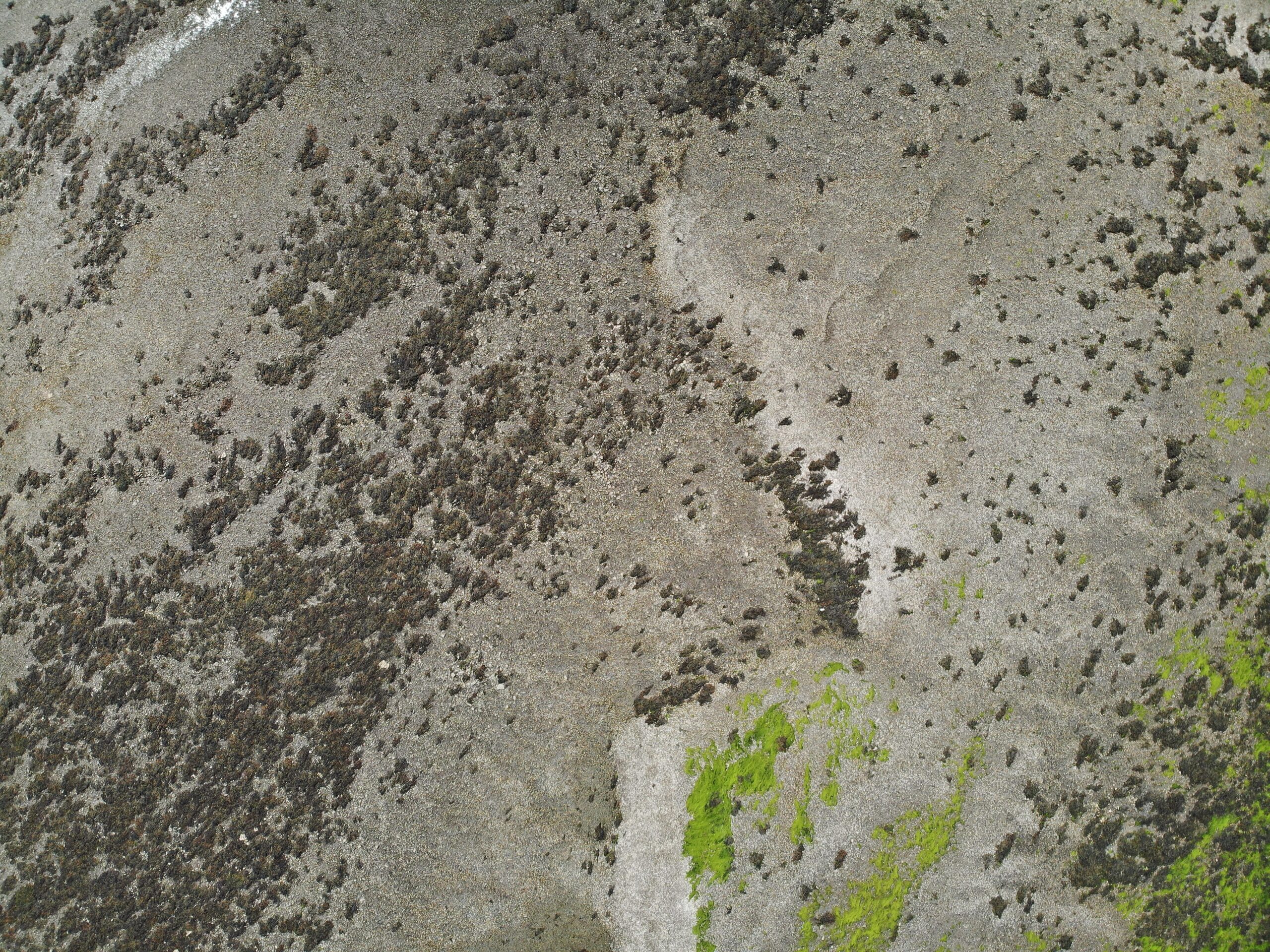
The Taw-Torridge Estuary is designated as a Site of Special Scientific Interest (SSSI). Similarly to the Exe Estuary, it is an important roosting site for overwintering birds. The intertidal mussel beds within the estuary serve as an important food source for many of these birds and are recognised as such. D&S IFCA has been monitoring these intertidal beds since 2012. The intertidal mussel beds in the Taw-Torridge have also suffered significant reductions in both population size and biomass, as well as spatial coverage, following the 2014 storms. With the decline in mussel stock, not only in the Estuary but nationwide, and an increased interest in shellfishermen from across the country wishing to harvest the mussels, Natural England and D&S IFCA introduced management measures to place a restriction on the amount of mussels that can be harvested commercially from the intertidal beds within the Taw Torridge. This is to ensure that enough mussels would be available to provide an adequate food supply for the birds for which the SSSI is designated. The estimated mussel stock calculated in D&S IFCA’s intertidal stock assessments feed into a shellfish ecological requirement model which calculates the maximum amount of mussels that can be removed per month by fishers.
D&S IFCA has recently collaborated with Bournemouth University, Association of IFCAs, Natural England and EAD Ecology on a project to assess the shellfish food requirements of oystercatcher (Haematopus ostralegus) overwintering in the Taw Torridge Estuary. This is to help update and inform the management of the site and its intertidal mussel fishery. This work is reported in Stillman et al. (2025).
D&S IFCA will continue to monitor the intertidal mussel beds for changes, to inform Natural England of food availability for wading birds and to ensure sustainable management of the intertidal mussel beds.
Taw Torridge (intertidal) Stock Assessments
- Taw Torridge Mussel Stock Assessment 2024 (V1.0 March 2025)
- Taw Torridge Mussel Stock Assessment 2022 (V1.0 March 2023)
- Taw Torridge Mussel Stock Assessment 2021 (V1.0 November 2021)
A collection of older reports can be found in Section H (Mollusca/Mussels) of the Resource Library.
Subtidal Mussel
Until 2020, the extent and density of the subtidal mussel resource in the Taw-Torridge system had not previously been assessed, though the subtidal mussel may play an important role in reseeding intertidal areas, providing food and habitat for local wildlife, and performing other important ‘ecosystem services’. Therefore, in October 2020, D&S IFCA worked with two local fishermen to conduct a broad-scale survey of the estuary. This survey used a device known as a Van Veen grab, deployed from a local fishing vessel, to take samples of the estuary bed from the Crow Point/ Coolstone area through the main channel to the estuary mouth. Sample areas were guided by important fisher knowledge of the local environment. The objective of this project was to define the location of subtidal mussel beds, ground-truthing and updating local knowledge of mussel distribution. The contents of all Van Veen grab samples were assessed for mussel presence, abundance and mussel length. Results of this survey have expanded D&S IFCA’s understanding of the subtidal mussel resource, which will help to inform future management of local mussel beds and the development of shellfisheries in this part of the D&S IFCA’s District. Further research was undertaken in 2021 to increase D&S IFCA’s knowledge of the system and improve the capacity to sustainably manage the shellfishery within ecological limits.
Taw Torridge (subtidal) Assessments
- Taw Torridge Subtidal Mussel Assessment 2021 (V1.0)
- Taw Torridge Subtidal Mussel Assessment 2020 (V1.0)
End.
